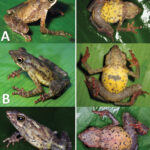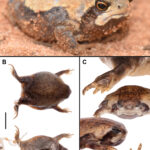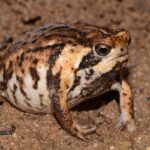Atelopus fronterizo: Discovering the Enigmatic Frontier Stubfoot Toad#
Hidden deep within the lush emerald growth of South America’s cloud forests exists an amphibian species whose very existence symbolizes resilience and fragility in equal measure—the Atelopus fronterizo. Commonly named the Frontier Stubfoot Toad, this fascinating creature is aptly named for its occurrence near country borders, earning its distinctive scientific epithet fronterizo, meaning “belonging to the frontier” in Spanish. Though modest in size, Atelopus fronterizo holds an essential ecological role and intriguing biological history, captivating conservationists and amphibian enthusiasts alike.
First described formally only recently by conservation biologists and herpetologists, Atelopus fronterizo immediately captured attention due to its striking coloration, rare appearance, and unfortunately, precarious population status. Its discovery ignited a renewed fervor for protecting the delicate habitats upon which many amphibians depend, resonating widely as a symbol of the shifting boundaries between pristine nature and humanity’s impact.
Taxonomy and Classification#
The Frontier Stubfoot Toad belongs to the Bufonidae family—familiarly known as True Toads—and is nestled firmly within the genus Atelopus, commonly referred to as harlequin toads. Scientifically recognized as Atelopus fronterizo, it shares its genus with approximately 100 other brilliantly colored and ecologically vital species.
Harlequin toads, including Atelopus fronterizo, are celebrated for their eye-catching, vibrant patterns and unique ‘stub-like’ digits on their limbs, from which the common term “stubfoot” originates. The genus Atelopus spans a colorful assortment of amphibians known historically for their ecological abundance yet tragically modern-day rarity. Within the genus, many species have dramatically declined over recent decades, making Atelopus fronterizo’s discovery incredibly poignant. It stands as a crucial link within the broader conservation narrative unfolding around these unique amphibians.
Natural Habitat#
Atelopus fronterizo finds its home among the mist-shrouded slopes of mountainous tropical cloud forests, particularly along the Ecuadorian-Colombian border region. This delicate, elevational habitat is characterized by a constant interplay of humidity, sunlight, and rainfall, forming the perfect sanctuary for moisture-dependent amphibians. Towering trees wrapped in a tapestry of mosses and bromeliads grace these landscapes, providing cover and microhabitats ideal for amphibian life.
Here among the damp leaf-litter carpets that coat the forest floor, Atelopus fronterizo navigates an intricate world shaped by fog and drizzle. Clear, shallow streams slice through these habitats, bubbling melodically beneath dense, overarching foliage. This precise environmental niche is especially vital for Frontier Stubfoot Toads, as they depend deeply on clean flowing water not only for daily survival but also for reproductive purposes.
Indeed, the health of these streams directly correlates with the welfare of amphibian populations. The fact that Atelopus fronterizo thrives in such distinctly pristine landscapes underscores their role as living indicators of environmental wellbeing.
Physical Characteristics#
One of the most captivating features of Atelopus fronterizo undoubtedly comes from its dazzling appearance. Adults of the species are modest in size, typically averaging around 3 to 4 centimeters from snout to vent. Despite their small stature, they exhibit a riot of vibrant colors—typically blends of vivid yellow, luminous green, fiery orange, and bold black patterns that artistically decorate their compact figures.
These striking hues, wildly divergent from the muted browns and greens common to many amphibian species, play more than a decorative role. Such brilliant coloration is characteristic of “aposematism,” a biological phenomenon acting as a natural deterrent. Predators quickly learn to associate bright coloration with potential toxicity, enabling the toads to carry boldly forth without constantly hiding in the shadows.
As suggested by their common name “stubfoot,” Atelopus fronterizo possesses short, reduced digits—distinctive adaptations providing remarkable traction on slippery, streamside rocks and damp vegetation. Coupled with their vibrant skin, delicate limbs, and vigilant, protruding eyes, their peculiar physical adaptations come together in harmony, perfectly tailored to their specialized habitat.
Behavior and Life Cycle#
Feeding Habits and Predatory Behavior#
With its striking appearance, Atelopus fronterizo may give the impression of being bold and assertive, yet it follows a quiet, solitary lifestyle, with diet patterns typically consisting of small invertebrates. Hunting primarily during daylight hours, it employs a highly patient and methodical hunting approach, snatching prey such as ants, small beetles, spiders, and even occasional caterpillars from leaf litter or low vegetation with swift, precise flicks of its tongue.
Breeding Patterns and Parental Care#
The onset of breeding season sees Frontier Stubfoot Toads congregating near crystal-clear forest streams, males announcing their readiness through melodic and somewhat ethereal calls that echo beneath the forest canopy. These distinctive vocalizations, resonant and rhythmically repetitive, act not only as calls to prospective mates but also signify territorial claims among competing males.
Once the female selects a mate, she deposits clusters of eggs in carefully sheltered pools or streambeds—places rich in oxygenation and with minimal predation risk. The male fertilizes these immediately, guarding the eggs vigilantly for the duration of their gestation against potential aquatic predators or intruders. Such evident parental vigilance is an intriguing behavior trait observed across only a portion of amphibian species, highlighting further the unique life-history adaptations adopted by Atelopus fronterizo.
The hatchling tadpoles emerge into an aquatic realm rich in algae and detritus, upon which they feed voraciously, transitioning over time into gorgeously patterned froglets—a miniature yet equally vibrant mirror image of their parental generation.
Ecological Role#
Far from merely ornamental forest residents, Atelopus fronterizo and similar harlequin toads fulfill critical roles in maintaining forest ecosystem balance. As predators consuming a variety of insects, they regulate invertebrate populations, indirectly influencing plant life and nutrient cycling processes occurring within the delicate soil ecosystems of cloud forests.
Moreover, the Frontier Stubfoot Toad serves as both prey and biological indicator, its presence indicative of pristine ecosystem health. Predators such as snakes, birds, and small mammals incorporate toads into their dietary patterns, thus highlighting these amphibians’ broader interconnectedness within the forest food web.
Threats and Conservation Status#
Regrettably, Atelopus fronterizo exemplifies vulnerability faced by amphibians worldwide. While relatively recent scientific description means comprehensive data are still forthcoming, initial insights reveal population pressures from anthropogenic habitat fragmentation, encroaching deforestation, and, most threateningly, the devastating effects of chytridiomycosis—a fungal disease responsible for catastrophic amphibian population declines across the globe.
Although Atelopus fronterizo’s detailed IUCN assessment remains pending due to its recent classification, many closely related harlequin toad species are critically endangered or even extinct in the wild. This backdrop underscores urgency in conservation strategies, from habitat protection and restoration to carefully orchestrated captive-breeding programs and potential disease intervention efforts designed explicitly for species’ survival.
Cultural and Scientific Significance#
The vibrant toads of the Atelopus genus hold rich cultural resonance within indigenous and local communities inhabiting Colombia and Ecuador border regions, often symbolizing environmental harmony and ecological health.
Beyond cultural symbolism, amphibians like Atelopus fronterizo also provide substantial scientific value. Amphibians help researchers understand ecological dynamics, evolutionary biology, and the profound implications of environmental shifts, including climate change. Discovering novel compounds in their skin secretions also offers tremendous potential for advances in human medicine, producing substances valuable for pharmaceutical developments.
Conclusion: A Call for Conservation#
The Atelopus fronterizo represents a compelling testament to the extraordinary beauty concealed within nature’s delicate tapestry. Their existence eloquently reveals the interdependence of life, subtly teaching humanity about stewardship, conservation ethics, and ecological wisdom.
As admirers of wildlife, stewards of natural beauty, and advocates for conservation, we must commit ourselves to safeguarding these captivating amphibians. By actively supporting conservation efforts, demanding habitat protection, and promoting awareness campaigns, we empower collective conservation action.
Let the Frontier Stubfoot Toad’s enchanting colors remind us all not only of nature’s breathtaking beauty but also of our inherent responsibility to guard fiercely those rare wilderness spaces where such wonders continue to survive.







